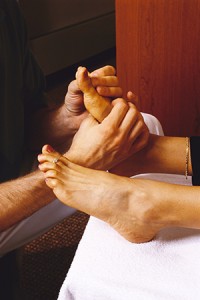
Reflexology works on the principle that there are reflex points in the feet that correspond to the organs in the body. The stimulation of these reflex points causes the thousands of nerve endings in each foot to respond, enabling change in every cell, tissue, gland and organ.
by Fatina Hijab —
The art of reflexology has a definite place in our modern world. Human feet are equipped with curves, nerves, muscles and bones of many shapes and sizes. Although our ancestors walked the earth with bare feet, we have embraced paved streets that cause our arches to collapse and tortuous, tight-fitting shoes to walk them. As a result, many people experience one kind of foot pathology or another.
Reflexology relaxes the tendons, ligaments and muscles, opening up the spaces between them and allowing blood to flow and nurture the feet. In addition to keeping feet healthy, reflexology is beneficial to the entire body. It helps stimulate the internal functions of the body’s 11 systems, improving circulation, promoting relaxation, assisting detoxification and much more.
Reflexology works on the principle that there are reflex points in the feet that correspond to the organs in the body. The stimulation of these reflex points, using hand techniques, causes the thousands of nerve endings in each foot to respond, enabling change in every cell, tissue, gland and organ.
Chinese Traditional Medicine (CTM) has a long, rich history of combining various modalities, including reflexology or what the Chinese refer to as yu fu. The word yu means healing, while fu means foot. Today, Chinese reflexology blends CTM and Western medicine — in particular, neurophysiology.
From the CTM perspective, reflexology works through channels of energy (qi). A problem in the body indicates that the channels are blocked. By working the reflex points in the feet, the blockage is removed and the equilibrium of yin and yang is restored.
Fatina Hijab practices Chinese reflexology. She is a certified and registered reflexologist, both in the U.S. and in China. 480-242-2373, www.trueharmonywellness.com or rightunderyourfeet@yahoo.com.
Reprinted from AzNetNews, Volume 24, Number 5, October/November 2005.





July 27, 2013
Bodywork, Chinese medicine, Natural medicine and Natural Therapies, Reflexology